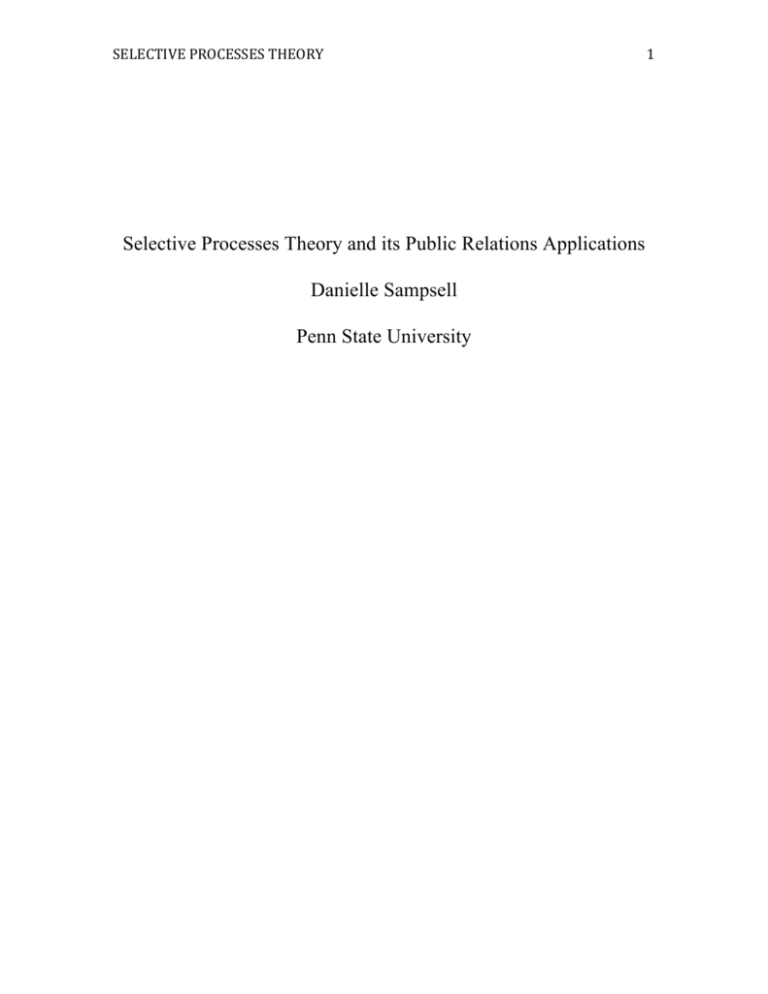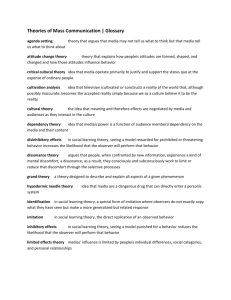Selective Process Theory - Sites at Penn State
advertisement

SELECTIVE PROCESSES THEORY Selective Processes Theory and its Public Relations Applications Danielle Sampsell Penn State University 1 SELECTIVE PROCESSES THEORY 2 Abstract This paper explores the selective processes communication theory and its implications on the public relations field of study. The selective process theory is comprised of selective exposure, selective attention, selective perception and selective retention. Selective processes theory is considered a theory of media impact because it is concerned with the ways that society members consume the media that they choose to consume. The theory describes ways in which the media behaviors of people are affected by their biases, beliefs and values. Finally, these media choices and the selective processes theory helps public relations professionals understand what an effective message is for their organization and which forms of media are best to use as the medium for any given message to consumers. SELECTIVE PROCESSES THEORY 3 Introduction The selective processes theory, as stated in the abstract, is comprised of selective exposure, attention, perception and retention. This paper attempts to thoroughly explain the selective processes theory and the role in plays in the field of public relations. Understanding how the selective processes theory affects public relations professionals and their respected organizations is important because the theory provides insight as to why and how consumers choose to give their time and attention to specific media and advertisements as opposed to others. Public Relations professionals must understand how to use the media to their advantage with clients and consumers in order to successfully brand their products. The selective processes theory will help to explain and answer questions about the media choices of consumers. SELECTIVE PROCESSES THEORY 4 Description of Theory The selective processes theory is a useful model for attempting to explain the media choices of individuals. The selective processes theory is comprised of the four steps of selective exposure, attention, perception and retention. The theory, overall, says that people choose messages and media that align with their current beliefs, values and ideas as opposed to messages and media that go against their current beliefs, values and ideas. Through selective processes theory, individuals interpret the media in their own way and tend to avoid messages that do not confirm their beliefs (Whitaker, Ramsey & Smith, 2012). Selective processes theory gets its origins from cognitive dissonance theory. This theory states that people experience mental stress or discomfort when they are confronted by new information that contradicts their existing beliefs, values and ideas. When this discomfort is experienced, individuals attempt to reduce it and actively seek out information that reduces their feelings of dissonance (Stroud, 2010). Clearly, cognitive dissonance directly relates to the selective processes theory. However, with selective processes, an individual does not seek out information for the purpose of lowering their dissonance level. Instead, individuals only give their time and attention to messages and media that align with their pre-existing beliefs. The first two steps in selective processes theory are selective exposure and selective attention. These steps are synonymous and refer to the idea that individuals’ interests, SELECTIVE PROCESSES THEORY 5 opinions and beliefs influence the information, media and messages that their attention is given to. It is the nonrandom process by which people purposely choose which messages to view and which messages to ignore completely. Because it is impossible to read, hear and see every message available in the media, people selectively expose themselves to messages they feel will be of interest or help to them. Along with this, people tend to seek out viewpoints with which they expect to agree. People use the media to reinforce existing biases, beliefs and opinions (Whitaker et al, 2012). After an individual meticulously chooses the messages he or she wishes to be exposed and give attention to, the next step in the selective processes theory is selective perception. Selective perception is all about how individuals interpret the information they have decided to give their attention to. People often interpret messages how they want to and often choose to only hear and see the portion of the message they want to. Individuals will alter the meaning of messages so they become consistent with their preexisting beliefs and attitudes (Smith, 2012). Thus, one message and one set of information may carry extremely different meanings for different people, depending on their various backgrounds, values, attitudes, beliefs and ideas. The final process of the selective processes theory is selective retention. This phase is all about memory recall with the selected exposed and perceived information from various messages. People have a tendency to remember messages that support their beliefs rather than messages that contradict their beliefs. Also, individuals remember information for a longer period of time when it coincides with their attitudes and beliefs as opposed to SELECTIVE PROCESSES THEORY 6 when the information does not. Research states that along with this, people unconsciously forget or set aside the information that opposes their preexisting beliefs (Stroud, 2010). Throughout the various selective processes phases, it is evident that individuals both consciously and unconsciously prefer messages that align with their preexisting beliefs as opposed to those that do not confirm preexisting beliefs. In this regard, such tendencies make it less likely that the media can play a sole role in changing the attitudes and behaviors of consumers. For media consumers and individuals across the globe, messages that reinforce the values of an individual will almost always be preferred to those that do not. SELECTIVE PROCESSES THEORY Conceptual Model 7 SELECTIVE PROCESSES THEORY 8 Public Relations Application The selective processes theory is important for communications and public relations professionals. The media behaviors of individuals are affected by their preexisting biases, beliefs and opinions. Quite simply, people will only pay attention to and remember messages that coincide with their current beliefs and attitudes. Therefore, in order for a public relations professional to successfully reach their various publics and consumers, the messages they develop and place in the media must be messages of which individuals will align their beliefs and attitudes toward. The first step in the process of ensuring the message of a company or organization is heard and positively received is to make sure the message will capture the attention of its viewers. Then, not only must the message be interesting and attention grabbing, but it must also contain viewpoints that the majority of individuals whom the company wants to attract the attention of agree with. These viewpoints and beliefs must then be properly interpreted and favored by the audience members. Public relations professionals must craft creative, popular messages that align with their publics’ beliefs if they want to be successful. Understanding the selective processes theory is important to the field of public relations, because it explains how and why some messages are more well-perceived and remembered than others in the media. It also explains the importance of conducting research prior to implementing a campaign, in order to better understand the target audience and various publics of a company or SELECTIVE PROCESSES THEORY 9 organization. One example of a company who utilized the selective processes theory through their implementation of a public relations campaign is AT&T. Their 2013 “Be The Fan” campaign was a season-long partnership with NCAA College Football Game Day. It was a social media and marketing campaign with the purpose of attracting more football fans to watch and be a part of the college football Saturday morning Game Day experience on ESPN. The campaign utilized comedian Eric Stonestreet to star as the “fan coach” and be present in every commercial, contest and online video. Along with using a famous comedian, AT&T also used comedy throughout their advertisements, language and symbols familiar to college football fans and the use of social media to better involve their audience (Westney, 2013). Their campaign utilized selective processes theory because the company paid close attention to the beliefs and attitudes of the audience they were trying to appeal to, which was a college football fan. Through their use of comedy, football and familiar faces, AT&T was able to successfully capture the attention of their target audience. Along with this, their social media numbers and media impressions indicate that the majority of their target audience perceived their messages in positive manners, aligning with their previously held beliefs. Selective retention was also present in this campaign, as one year after the campaign was implemented, AT&T users and college football Game Day fans provided feedback to the company and even requested that the campaign be implemented on an annual basis. SELECTIVE PROCESSES THEORY 10 AT&T clearly understood their target audience and how they would best react to messages and media uses by the company. Their campaign was voted as one of the top ten public relations campaigns in 2014, and AT&T increased their customer satisfaction ratings by more than 45 percent. SELECTIVE PROCESSES THEORY 11 Conclusion The selective processes theory is commonly used in the fields of communication and psychology. It is comprised of four key phases, selective exposure and attention, selective perception and selective retention. The main idea of the theory is that individuals will choose to expose themselves to and remember best the media messages that align with their preexisting beliefs and attitudes. On the contrary, individuals will choose to ignore media messages that go against their core values, beliefs and attitudes. This theory holds important implications for public relations professionals. In the realm of public relations, one must conduct thorough research on their target audience in order to ensure that all crafted messages will be reached, correctly perceived and remembered by that target audience. Selective processes theory will continue to be an important communication theory and is important to understand in order for public relations professionals to develop successful organizational campaigns. SELECTIVE PROCESSES THEORY 12 Reference List Smith, Ronald. (2012). Communication Theory and Research. Journal of Media and Communication Studies. 7(2). 5. Stroud, Natalie. (2010). Media Uses and Political Predispositions: Revisiting the Concept of Selective Exposure. International Journal of Communication. 4. 3-11. Westney, Andrew. (2013). AT&T’s “Be The Fan” Campaign Courts Social Media Audience with “Modern Family” Star. Sports Business Journal. Online ed. Whitaker, R., Ramsey, J., & Smith, R. (2012). Media Writing: Print, Broadcast and Public Relations. (4th ed.) Buffalo, NY: Routledge.





